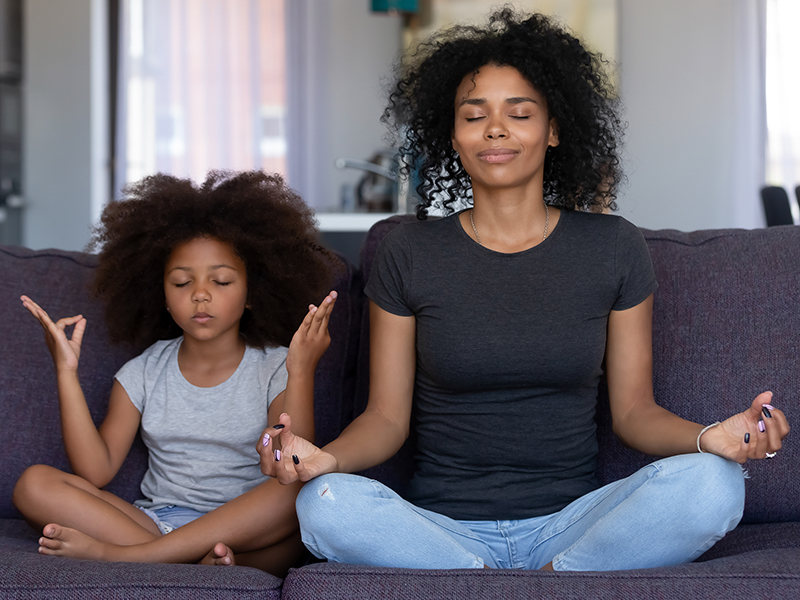Many adults swear by the ancient practice of yoga for stress relief; to improve flexibility, balance and strength; and to enhance daily focus. With playful names like downward dog, cat, cow and gorilla, yoga poses easily inspire the imagination of the younger set.
Libbey York enrolled her sons Graham, 8, and Lawson, 4, in a children’s yoga class last summer, thinking they could meet friends and try something new. Their response surprised her.
“They couldn’t stop talking about all of their new moves and practicing their poses all around the house,” she says.
Graham likes practicing seated crossed-legged pose and Lawson loves to show off his tree pose. In addition to enhancing her sons’ flexibility and strength, “the class improved their focus and body awareness as they attempted the poses,” says York, who is also a yoga practitioner and instructor.
Linking mind and body. Yoga, which in Sanskrit means “to yoke,” nurtures a connection between the mind, body and spirit. Balancing poses like airplane and tree, for example, strengthen muscles and require mental focus and concentration to achieve and hold.
Overall, multiple studies have found that yoga can help kids improve academic performance, physical fitness, self-awareness, self-esteem, concentration, emotional balance and behavior.
Slow down and breathe. In a “Stress in America” survey conducted by the American Psychological Association, more parents than non-parents reported that they struggled to manage the stress of jobs and family responsibilities. Since children pick up on the tensions of their caregivers, they may internalize more stress, too. Multiple studies have found that yoga offers effective stress relief for all ages.
“In this fast-paced world in which we live, children need to know how to relax and breathe and mindfully move through their day,” says yoga instructor Katy Henderson. “Teaching children how to breathe in yoga allows them to take that crucial breath before they get mad, angry or frustrated.”
Focus power. In a study conducted by School Psychology Review, researchers found that regular yoga practice can help children with attention deficit and hyperactivity disorder (ADHD) learn to calm their minds and focus on the present, improving on-task time and attention. And thanks to the proliferation of distracting electronic devices, even kids who don’t suffer from ADHD can benefit.
A Kaiser Family Foundation study found that children spend an average of seven and a half hours daily engaged with screen technology. The mindfulness techniques that yoga practice offers can help kids re-focus on the present and concentrate on tasks like homework and chores that require their undivided attention.
Strike a pose. According to the Centers for Disease Control and Prevention, more than 12 million kids between the ages of 2 and 19 years are considered obese. Yoga offers a gentle way to get kids moving, strengthen muscles, improve flexibility and practice gross motor skills.
“For the child who is not particularly active, yoga provides an avenue to move in a playful, engaging way,” Henderson says.
Spread the love. “Yoga fosters self-acceptance and self-actualization. It invites all participants to improve concentration and focus, and even helps develop self-compassion and compassion for others,” writes Kristin Henningsen, adjunct professor at Kaplan University School of Health Sciences in her report “The Benefits of Yoga for Children.”
Pauline Emmett, a YoKid Ambassador, agrees. “In practicing yoga, children experience better self-esteem, and therefore have the confidence to trust themselves as being strong and capable beings,” she says. “We talk about self-love, and how if we love ourselves, we can better care for our friends, family and the world.”
To learn more about area classes and workshops for your kids, visit namastekid.com or check out your local community center, area gyms and yoga studios.
Introducing kids to yoga
- Start your child’s day off with some simple stretches and end the day with three deep belly breaths before bed.
- Purchase or borrow a yoga video geared toward kids.
- Check out YouTube for free children’s yoga instruction videos.
- Role model and invite your kids to join you during your yoga practice.
- Discover “The Kids’ Yoga Deck: 50 Poses and Games” by Annie Buckley.
- Look for classes and workshops in the area.
- Lead your child through a few simple yoga stretches and breathing exercises before homework time to help with focus and concentration.
- Tell stories using yoga poses.
- Along with your child, follow the soothing illustrations and simple exercises in “Good Night Yoga: A Pose-by-Pose Bedtime Story” by Mariam Gates, the founder and director of Kid Power Yoga.

